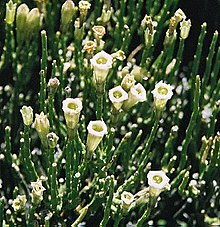Fabiana
| Fabiana | ||||||||||||
|---|---|---|---|---|---|---|---|---|---|---|---|---|

Fabiana imbricata |
||||||||||||
| Systematics | ||||||||||||
|
||||||||||||
| Scientific name | ||||||||||||
| Fabiana | ||||||||||||
| Ruiz & Pav. |
Fabiana is a genus ofthe nightshade family . The 15 species occur exclusively in areas of western South America . The scientific generic name honors Francisco Fabián y Fuero (1719–1801), Archbishop of Valencia (1773–1794), and patron of botany.
description
Vegetative characteristics
The Fabiana species are small-leaved and ground-covering shrubs that are usually 0.2 to 1.5 m high, but rarely reach sizes between 0.04 and 3.5 m. In some species, the branching forms of young and older plants differ. The stem axis and the foliage leaves lack crystal sand , but they form drusen and are resinous due to their dense, glandular hair. The phellogen forms the epidermis , the pericycle has strong fibers, the internal phloem is not fibrous.
The leaves are sessile, overlap, in clusters, rosettes or individually, they lack fibers surrounding the leaf veins. They are very small with only 1 to 8 mm in length and 0.5 to 0.8 mm in width, their shape is narrowly inverted ovoid, ovoid, cylindrical, linear or scale-like, occasionally they are tiny or completely absent.
blossoms
The flowers stand individually on flower stalks 0.8 to 6 mm long or are sessile. They are a little fragrant. The calyx consists of five, partially fused sepals. It is radially symmetrical, cylindrical, bell-shaped or slightly urn-shaped, mostly it is 3 to 9 mm long, but can also be between 2.5 and 15 mm long. The calyx lobes are linear or triangular and usually a little shorter than the corolla tube, only rarely as long. The five-fold and radially symmetrical crown is bell-shaped or plate-shaped and 8 to 20 mm long. It is usually whitish in color, only in exceptional cases purple or bluish, occasionally it is yellow with red or purple stripes.
The five stamens are usually divided into three short and two long ones, only in two types are all five of the same length. All stamens start at the same height in the lower half of the corolla tube, usually they are bent knee-shaped at both ends. The anthers are fixed on the back and can be a little wider than long and then 0.5 to 0.7 mm long or oblong and then 1 to 1.3 mm long. The counters stand separately from one another or are grown together in seven ways and only stand free from one another in the lower half. The pollen grains are small, spherical or flattened spherical with a diameter of 25 to 28 µm. They are separate from one another, mostly trizonocolpat (the three germ folds are on the pollen equator) or sometimes tetracolpat (provided with four germ folds). The pollen grain wall (exine) is slightly wrinkled. The nectaries are inverted and bilobed. The scar is usually saddle-shaped or head-shaped.
The flowers are fertilized by swarmers .
Fruits and seeds
The fruits are septum-split capsules with two split seed chambers. 30 to 52 seeds are formed per fruit . These are multi-faceted, angled and 0.6 to 1.6 mm long, the seed surface is finely honeycombed. The embryo is straight or only slightly curved, the cotyledons are small and significantly shorter than the rest of the embryo. Endosperm is abundant.
Other features
Chromosome numbers are only known from Fabiana denudata and Fabiana imbricata , where or was determined. Studies on secondary plant substances are mainly carried out on Fabiana imbricata , from which, among other things, the alkaloid Fabianin was extracted.
Occurrence and locations
The genus occurs exclusively between 16 and 51 degrees south latitude in western South America , along the Andes . Ten species occur in Argentina , five of which are endemic , two species can only be found in Chile , one exclusively in Bolivia .
Most species grow at altitudes between 1000 and 4900 m, only the Patagonian species Fabiana fiebrigii and Fabiana nana are widespread in the lowlands and rarely occur above 300 m.
use
Fabiana imbricata is used in folk medicine in Argentina and Chile.
Systematics
Within the genus 15 species are distinguished, the type species is Fabiana imbricata .
Here is a selection of the types:
- Fabiana bryoides Phil.
- Fabiana densa J. Remy
- Fabiana Denudata Miers
- Fabiana fiebrigii S.C. Arroyo
- Fabiana foliosa (Speg.) SCArroyo
- Fabiana friesii Dammer
- Fabiana imbricata Ruiz et Pav .: It occurs in Chile.
- Fabiana nana (Speg.) SCArroyo
- Fabiana patagonica Speg.
- Fabiana peckii Niederl.
- Fabiana punensis Arroyo
proof
literature
- Armando T. Hunziker: The Genera of Solanaceae . ARG Gantner Verlag KG, Ruggell, Liechtenstein 2001. ISBN 978-3-904144-77-3 .
Individual evidence
- ↑ Lotte Burkhardt: Directory of eponymous plant names . Extended Edition. Botanic Garden and Botanical Museum Berlin, Free University Berlin Berlin 2018. [1]
- ↑ Armando T. Hunziker: The Genera of Solanaceae . ARG Gantner Verlag KG, Ruggell, Liechtenstein 2001. ISBN 978-3-904144-77-3 .
- ^ GE Barboza and Armando T. Hunziker: Solanaceae, parte 8. Nicotianinae, parte A. Fabiana . In: Flora fanerogamica Argentina , Fasc. 56, 1996. Pages 1-9.
- ↑ Fabiana in the Germplasm Resources Information Network (GRIN), USDA , ARS , National Genetic Resources Program. National Germplasm Resources Laboratory, Beltsville, Maryland. Retrieved November 30, 2017.




